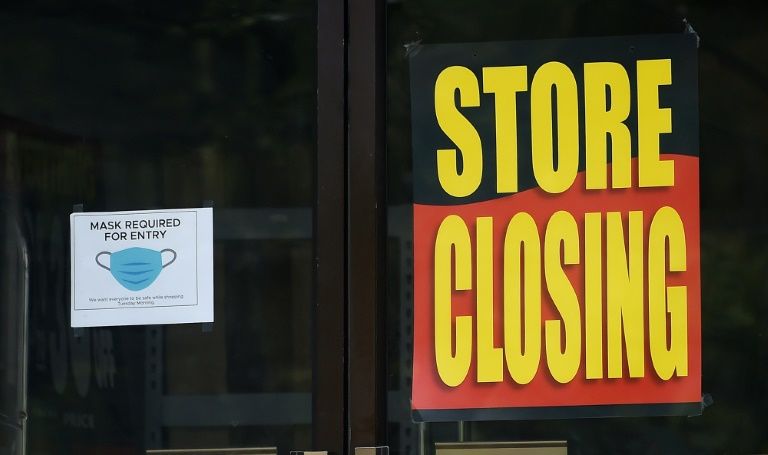US economy collapsed in Q2 amid pandemic, jobless claims rise
More businesses have had to shut down again as virus cases rise, undermining the nascent US recovery. ©AFP/File Olivier DOULIERY
Washington (AFP) – The US economy collapsed in the midst of the coronavirus pandemic, suffering its largest decline on record while hopes for a recovery took another hit as job losses increased, according to government data released Thursday.
The 32.9 percent GDP contraction, though slightly better than expected, was the worst experienced by the world’s largest economy since at least 1947 and underscored the severity of the rapidly unfolding crisis, which has already destroyed tens of millions of jobs.
While President Donald Trump continues to promise a dramatic recovery, COVID-19 cases have resurged in recent weeks, eroding early progress towards a rebound and forcing authorities in several states to reimpose restrictions that sent workers back home.
The latest Labor Department data showed a second straight weekly increase in initial claims for jobless benefits following several weeks of declines, prompting renewed calls for Congress to quickly approve a new round of emergency spending to support the economy.
The separate growth figures from the Commerce Department are given at an annual rate — a measure of the full-year result if the damage was translated over 12 months. Compared to the same quarter of 2019, economic activity fell 9.5 percent, still the worst figure since 1948.
“The staggering news of the historic decline of the gross domestic product in the second quarter should shock us all,” US Chamber of Commerce Executive Vice President Neil Bradley said in a statement.
The data “should compel Congress to move swiftly” to provide assistance to unemployed workers and businesses.
– Help for workers –
Congress is currently locked in debate over the size and composition of the next spending bill, with Democrats fighting to retain the $600 additional weekly payment made to unemployed workers set to expire Friday.
Republicans want to cut that money and offer businesses that reopen protection if some employees become infected.
“COVID is the iceberg. If we don’t want to be the Titanic, we need more lifeboats to traverse COVID-tainted waters,” Grant Thornton chief economist Diane Swonk said on Twitter.
US media reported the White House is pushing for a stop-gap measure that would extend the extra unemployment payments by one week as well as the moratorium on evictions for renters while negotiations continue.
Democratic House Leader Nancy Pelosi has opposed the plan, and she and top Senate Democrat Chuck Schumer are due to meet with Treasury Secretary Steven Mnuchin again late Thursday to try to bridge the differences.
Shortly after the data were released, Trump took to Twitter to rail against potential voter fraud and suggest postponing the November 3 election.
“Delay the Election until people can properly, securely and safely vote???” Trump tweeted, prompting many to say he was trying to distract attention from the awful numbers.
His opponent, former vice president Joe Biden, laid the blame squarely at Trump’s feet, pointing to the death toll from the virus in the United States which on Wednesday exceeded 150,000.
“The depth of economic devastation our nation is experiencing is not an act of God, it’s a failure of presidential leadership,” Biden said in a statement. “Had President Trump taken immediate and decisive action, tens of thousands of lives and millions of jobs would never have been lost.”
– Employment setback, stalled growth –
After surging in March amid the massive job losses at the start of the pandemic, first time claims for jobless benefits have been falling for weeks, but they rose again to 1.43 million in the week ended July 25, the Labor Department said on Thursday.
That figure does not include the 829,697 new claims by people who filed under a special program for those who would not normally be eligible for aid.
The data show “the resurgence in COVID-19 cases is taking a toll on the recovery in the labor market,” Oxford Economics lead US economist Nancy Vanden Houten said in an analysis.
Continuing claims, which is the number of people receiving benefits for more than a week, jumped to over 17 million while the insured unemployment rate rose to 11.6 percent in the week ended July 18.
Following a reduction of 5.0 percent in the first three months of the year, the GDP plunge was driven largely by the drop in its largest component, consumer spending, which fell 34.6 percent annualized, according to the report, which was the first estimate for the second quarter.
Trade also took a huge hit in the latest quarter, with exports falling just over 64 percent, and imports down 53.4 percent.
But personal income got a boost of $1.4 trillion from the government emergency spending measures that provided payroll funds for businesses and direct unemployment payments to workers.
Disclaimer: Validity of the above story is for 7 Days from original date of publishing. Source: AFP.


